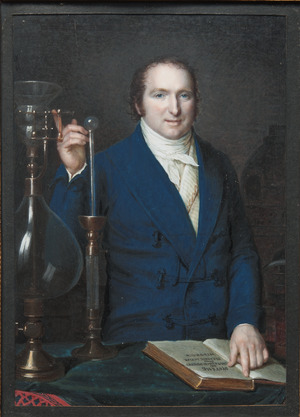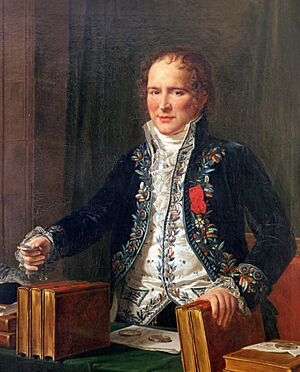Antoine-François de Fourcroy facts for kids
Quick facts for kids
Antoine-François de Fourcroy
|
|
|---|---|

Fourcroy with the first volume of his book Systeme des connaissances chimiques, painted by François Dumont c. 1800
|
|
| Born | 15 June 1755 Paris, France
|
| Died | 16 December 1809 (aged 54) Paris, France
|
| Resting place | Père Lachaise Cemetery |
| Known for | Co-discovered Iridium Co-founded Modern Chemical Nomenclature |
| Scientific career | |
| Fields | Chemistry Neurochemistry |
| Doctoral advisor | Jean Baptiste Michel Bucquet |
| Doctoral students | Louis Nicolas Vauquelin |
Antoine François Fourcroy (15 June 1755 – 16 December 1809) was an important French chemist. He worked with other famous scientists like Antoine Lavoisier. Together, they created a new way to name chemicals. This system helped make chemistry easier to understand.
Contents
Early Life and Education
Antoine Fourcroy was born in Paris, France. His father was a pharmacist for a duke. At first, Fourcroy studied medicine. It was hard for him because he didn't have much money. But he kept working and became a doctor in 1780.
His interest soon turned to chemistry. A chemistry professor named J. B. M. Bucquet inspired him. In 1784, Fourcroy became a chemistry teacher at the Jardin des Plantes in Paris. His lectures became very popular.
Amazing Chemical Discoveries
Fourcroy was one of the first to support Antoine Lavoisier's new ideas about chemistry. He helped share these ideas through his many writings. Fourcroy wrote many scientific papers, often with his assistant, Louis Nicolas Vauquelin.
Naming Chemicals
In 1787, Fourcroy worked with Lavoisier and others on a book. It was called Méthode de Nomenclature Chimique. This book created a standard way to name chemical compounds. This system is still the basis for how chemicals are named today.
Discovering New Elements
Fourcroy and Vauquelin also found a new metal. They found it in a leftover part of platinum. They called it "ptène." This name was later used for the element osmium.
Exploring the Chemistry of Life
Fourcroy believed that chemistry was very important for medicine. He thought studying the chemicals in plants and animals could lead to new medical treatments. He did much of this work with his assistant, Vauquelin.
Understanding the Brain
Fourcroy was especially interested in the chemistry of the human brain. He published several papers about his experiments. He studied the brains of people who had passed away. He found that the brain contains fatty substances, now called lipids. He also found other chemicals in the brain.
He used new methods to analyze brain matter. He found that the brain was made of fatty acids combined with other substances. He also helped rediscover phosphorus in the brain. This was an important step in understanding how our bodies work.
Improving Medical Education
Fourcroy also played a big role in changing medical education in France. He worked with another doctor, Francois Chaussier. They helped create a new law in 1794. This law combined medicine and surgery into one field. It also set up health schools that taught both.
Before this law, medical schools in France had different standards. Fourcroy's efforts helped create a unified system. This led to national licenses for doctors years later.
Modernizing Hospitals
Fourcroy saw problems in the hospitals of his time. Doctors often treated patients one by one. They didn't compare many cases to learn more about diseases. He suggested creating better clinical laboratories in hospitals.
He believed these labs should have young doctors who knew about modern science. He also wanted to use information from post-mortem exams. This meant studying bodies after death to understand diseases better. This idea helped link what doctors saw in patients to what they found after death. This was key for developing new medicines. Fourcroy was able to set up a teaching lab in Paris. This helped start the development of modern clinical laboratories.
Contributions to Society
Beyond science, Fourcroy was active during the French Revolution. He wanted to improve education in France. He held several important positions in the government. He was even president of the Jacobin party for a time.
Later, under Napoleon's government, Fourcroy became the Minister of Public Instruction in 1802. This meant he was in charge of all education in France. He held this important job until he died in 1809.
Legacy and Honors
The Chemical Revolution
Fourcroy helped explain the idea of the "Chemical revolution." He showed how chemistry was changing and becoming a separate science. He believed chemists were trying to find the basic structures of the natural world. He saw this as a team effort by scientists from many countries.
Awards and Recognition
In 1801, Fourcroy became a foreign member of the Royal Swedish Academy of Sciences. On the day he died, December 16, 1809, he was made a count of the French empire. He is buried in the Père-Lachaise Cemetery in Paris.
His 1787 book, Méthode de Nomenclature Chimique, was honored in 2015. It received a Chemical Breakthrough Award. This award recognized its importance in the history of chemistry.
It is believed that Cape Fourcroy in Australia is named after him. This cape was named during an expedition by Nicolas Baudin. Baudin had one of Fourcroy's books with him on his ship.
Images for kids
-
A marble bust of Fourcroy designed by Antoine-Denis Chaudet and completed by Pierre Cartellier in 1811.





